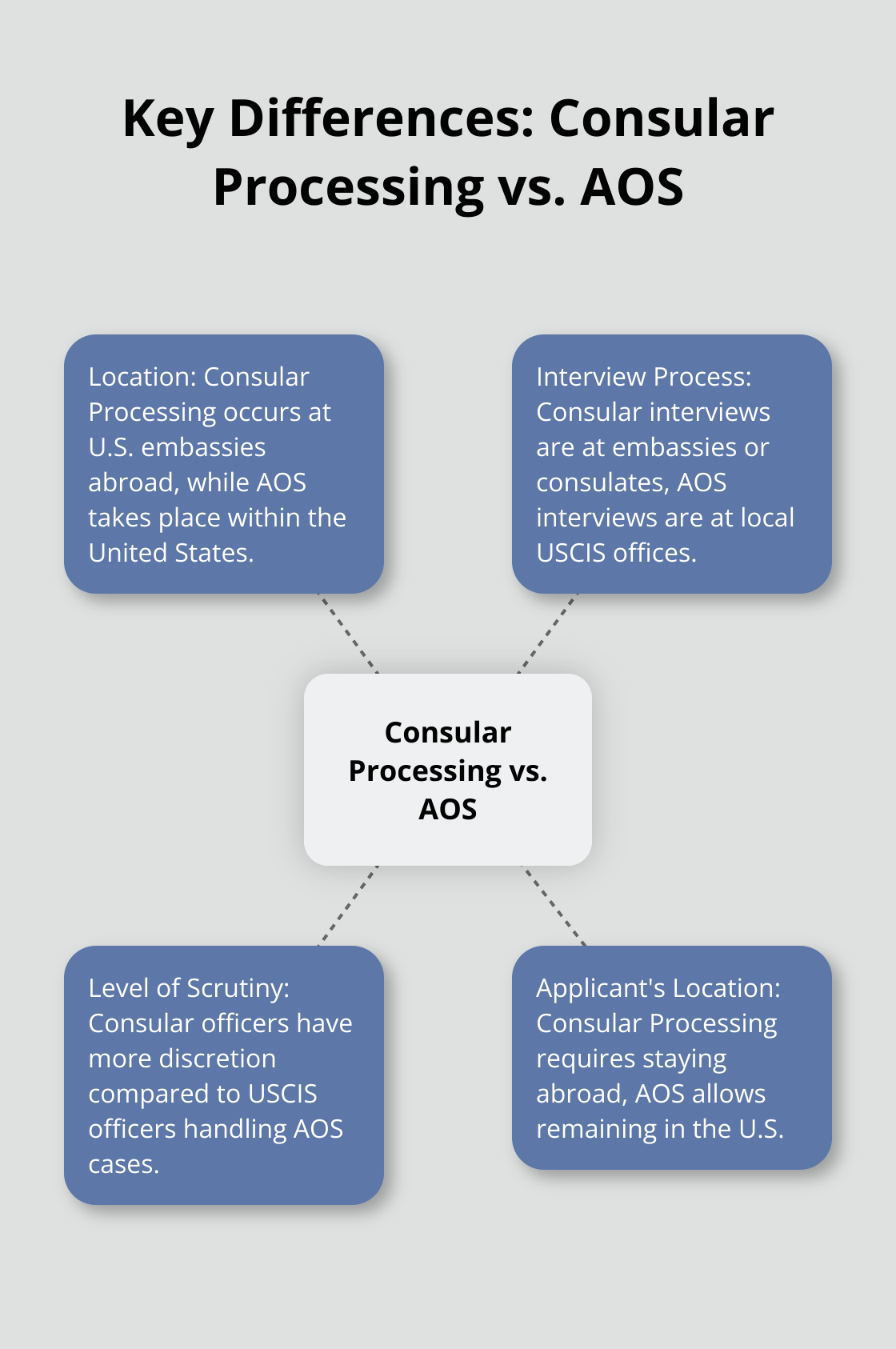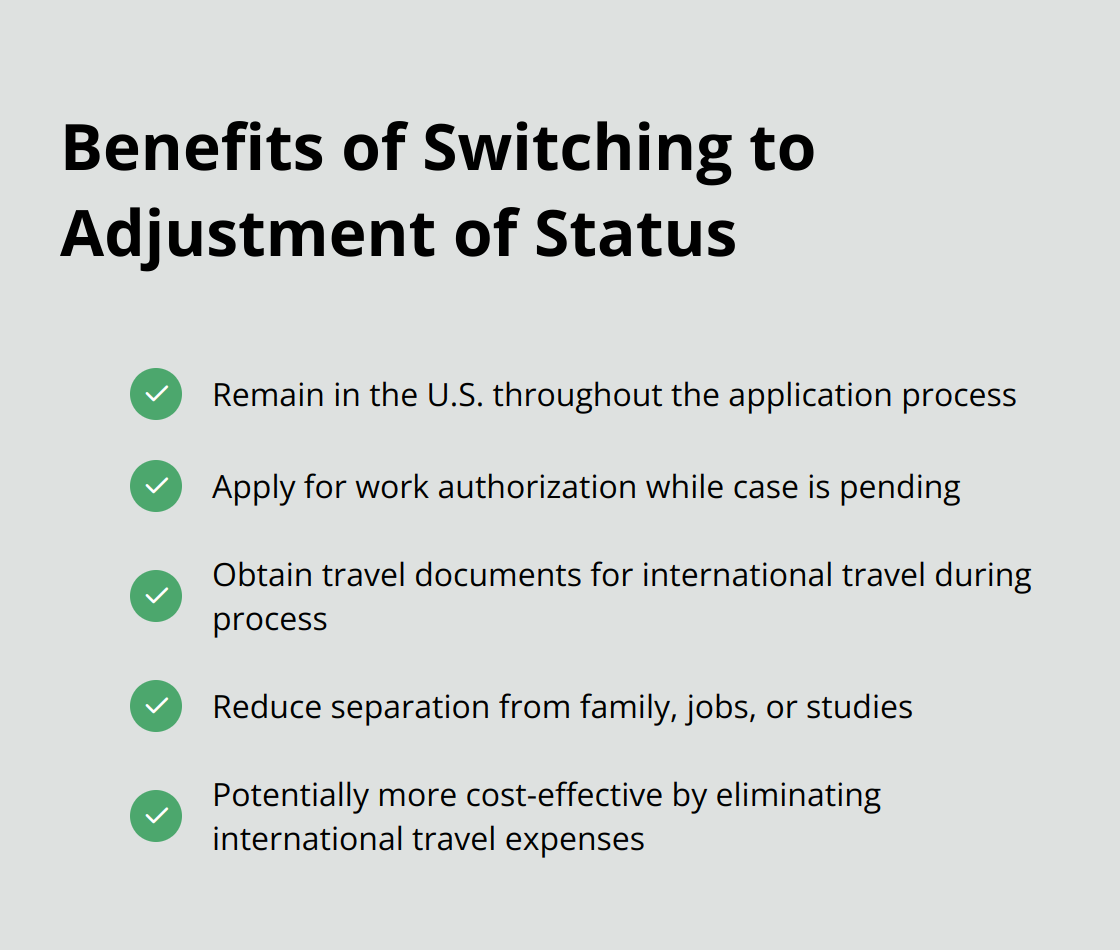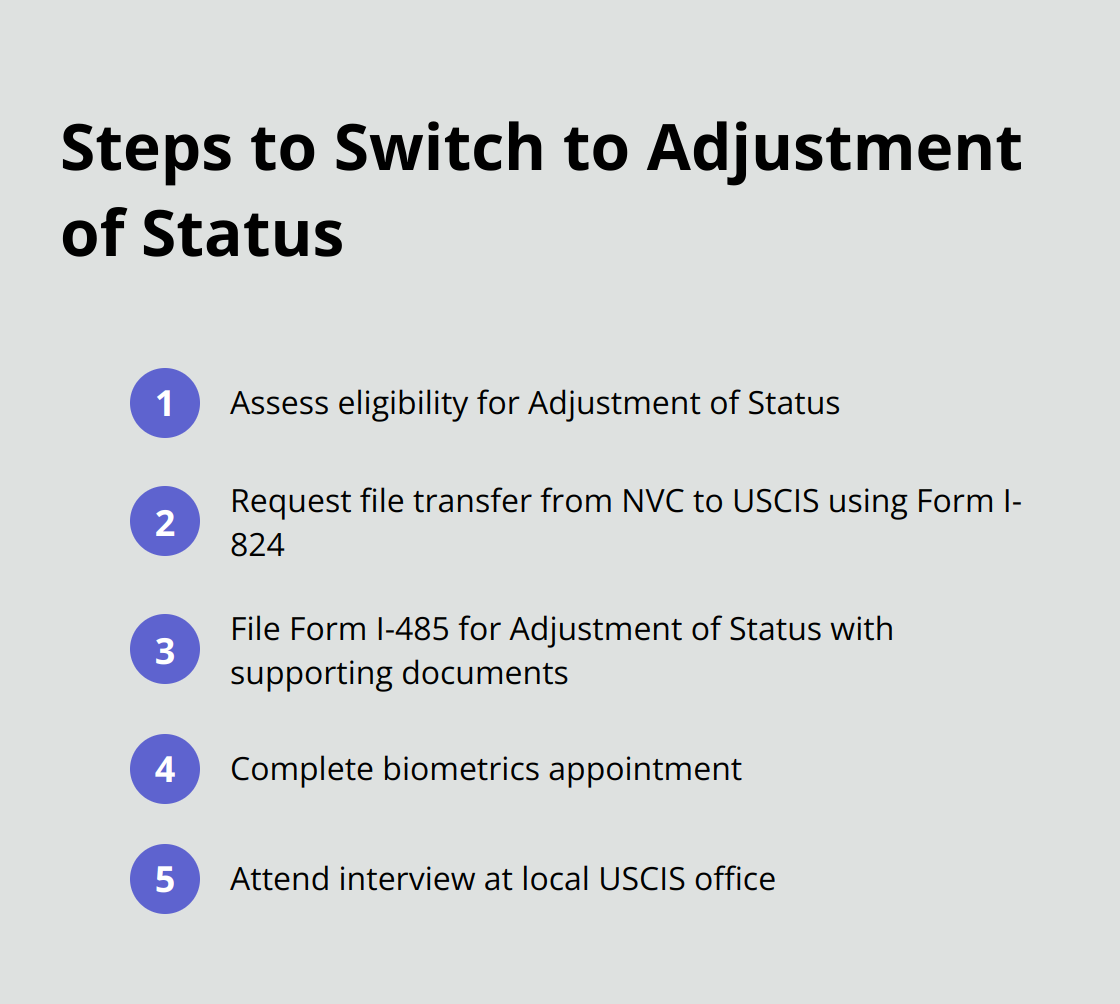
How to Switch from Consular Processing to AOS
Navigating the U.S. immigration system can be complex, especially when considering a transfer from consular processing to Adjustment of Status (AOS). At Law Offices of Jeffrey A. Thompson, we understand the intricacies of this process and its potential benefits for applicants.
This guide will walk you through the steps to switch from consular processing to AOS, highlighting the advantages and key considerations along the way. Whether you’re facing changes in personal circumstances or seeking a more efficient path to permanent residency, understanding your options is crucial for making informed decisions about your immigration journey.
What Are Consular Processing and AOS?
Consular Processing Explained
Consular Processing involves the application for a green card from outside the United States. Applicants must work with a U.S. embassy or consulate in their home country. The National Visa Center (NVC) collects necessary documents and fees before scheduling an interview at the consulate.
A key aspect of Consular Processing requires applicants to remain outside the U.S. until their green card receives approval. This can result in extended periods of separation from family or work in the United States.
Understanding Adjustment of Status
Adjustment of Status (AOS) allows eligible individuals already in the U.S. to apply for a green card without leaving the country. U.S. Citizenship and Immigration Services (USCIS) handles this process entirely within the United States.
AOS offers several advantages. Applicants can stay in the U.S. during the process, potentially continuing to work and live with their families. Additionally, AOS applicants may qualify for work authorization and travel permits while their case pends. USCIS data indicates that AOS processing times vary.
Key Differences Between Processes
The choice between Consular Processing and AOS often depends on an individual’s specific circumstances. Consular Processing might serve as the only option for those outside the U.S., while AOS is available to those who meet specific eligibility criteria and are already in the country.
A critical difference lies in the interview process. Consular interviews occur at U.S. embassies or consulates abroad, while AOS interviews take place at local USCIS offices within the United States. This can significantly impact travel costs and logistics for applicants.
Another important distinction involves the level of scrutiny. Consular officers often have more discretion in their decision-making compared to USCIS officers handling AOS cases. This can sometimes lead to different outcomes for similar cases.

Flexibility and Individual Circumstances
AOS can offer more flexibility for many applicants. However, each case is unique, and the best path forward depends on individual circumstances, current immigration status, and long-term goals in the United States.
The decision to pursue Consular Processing or AOS can have significant implications for an immigrant’s journey. As we move forward, we’ll explore the reasons why someone might consider switching from Consular Processing to AOS, and the potential benefits this change could bring.
Why Switch to Adjustment of Status
Unexpected Life Changes
Life often throws curveballs, and immigration plans may need to adapt. An individual might enter the U.S. on a temporary visa, planning to return home for consular processing, but find themselves with an opportunity to stay. For example, a student on an F-1 visa might receive a job offer that qualifies them for an H-1B visa, paving the way for Adjustment of Status (AOS). Similarly, a tourist might marry a U.S. citizen, creating an immediate path to permanent residency through AOS.
Streamlined Process and Reduced Separation
AOS allows applicants to remain in the U.S. throughout the application process. This eliminates the need for prolonged separations from family, jobs, or studies that often accompany consular processing. Processing times for AOS applications vary depending on the form, form category, and the office processing the case.
Furthermore, AOS applicants can apply for work authorization and travel documents while their case is pending. This means they can maintain employment and even travel internationally (with proper documentation) during the process, a flexibility not available to those undergoing consular processing.

Cost and Time Efficiency
While initial fees for AOS might be higher, the overall process can prove more cost-effective. Consular processing often involves international travel expenses, potential lost wages due to time away from work, and costs associated with maintaining two households during the process. AOS eliminates these additional expenses.
Time efficiency stands as another important factor. While AOS applications are processed entirely within the U.S., consular processing in countries with lower demand for U.S. visas may lead to quicker approval times. The choice between AOS and consular processing can impact overall processing times.
Flexibility and Control
AOS offers greater flexibility and control over the immigration process. Applicants can more easily communicate with USCIS, attend interviews at local offices, and respond to requests for additional evidence without the complications of international correspondence. This direct interaction can lead to a smoother, more transparent process.
The decision to switch from consular processing to AOS can significantly impact an immigrant’s journey. As we move forward, we’ll explore the specific steps involved in making this transition, ensuring you have all the information needed to navigate this important change in your immigration strategy.
How to Switch to Adjustment of Status (AOS)
Switching from consular processing to Adjustment of Status (AOS) requires careful planning and execution. This process involves several key steps to ensure a smooth transition.
Assess AOS Eligibility
The first step in transitioning to AOS is to determine eligibility. Applicants must be physically present in the United States and must have entered the country legally. Those who entered without inspection or have violated the terms of their visa may face challenges in qualifying for AOS.
Eligibility also depends on the immigrant category. Immediate relatives of U.S. citizens can generally apply for AOS at any time. However, family preference categories and employment-based immigrants must have a current priority date (as indicated in the Department of State’s Visa Bulletin).
Initiate the File Transfer
Once an applicant confirms eligibility, the next step is to request a transfer of the case file from the National Visa Center (NVC) to USCIS. This transfer requires filing Form I-824, Application for Action on an Approved Application or Petition. The current filing fee for Form I-824 is $465, and processing times vary by USCIS service center.
It’s important to note that filing Form I-824 does not automatically start the AOS process. It simply requests the transfer of the case file, allowing USCIS to process the subsequent AOS application.

File Form I-485
The core of the AOS process is Form I-485, Application to Register Permanent Residence or Adjust Status. This comprehensive form requires detailed personal information, immigration history, and the basis for adjustment. As of 2023, the filing fee for Form I-485 is $1,140, plus an $85 biometrics fee for applicants between 14 and 78 years old.
Applicants typically submit supporting documents alongside Form I-485, such as birth certificates, passport copies, and evidence of eligibility for the immigrant category. Many applicants also file Form I-765 for work authorization and Form I-131 for advance parole (allowing them to work and travel while the AOS application is pending).
Complete Biometrics and Interview
After filing, USCIS schedules a biometrics appointment where they collect fingerprints, photographs, and signatures. This information aids in background checks and identity verification.
The final step usually involves an interview at a local USCIS office. The interviewing officer reviews the application, verifies information, and may ask additional questions about eligibility. Preparation for this interview is essential, and many applicants find it beneficial to have legal representation present.
Final Thoughts
The transfer from consular processing to Adjustment of Status (AOS) offers numerous advantages for immigrants seeking permanent residency in the United States. This transition allows applicants to remain in the U.S., potentially obtain work authorization, and reduce travel expenses. The process involves assessing AOS eligibility, initiating a file transfer, and filing Form I-485 with supporting documents.
Biometrics appointments and interviews with USCIS officers complete the procedure, bringing applicants closer to their goal of permanent residency. At Law Offices of Jeffrey A. Thompson, we specialize in guiding clients through complex immigration processes like the transfer from consular processing to AOS. Our expertise in immigration law enables us to provide tailored advice, ensuring each step of the transition is handled correctly and efficiently.
A successful AOS application can yield significant benefits (such as maintaining employment and staying united with family members). It provides a direct path to permanent residency, opening doors to long-term opportunities in the United States. With proper preparation and expert guidance, applicants can navigate this transition effectively, bringing them closer to achieving their American dreams.


